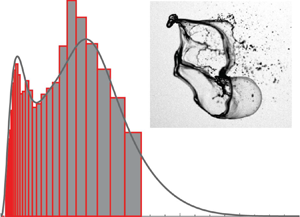Crossref Citations
This article has been cited by the following publications. This list is generated based on data provided by
Crossref.
Guo, Jianfeng
Kang, Peng
Mu, Kai
Li, Jianling
and
Si, Ting
2023.
On shock induced aerobreakup of a wall-attached droplet.
Journal of Fluid Mechanics,
Vol. 971,
Issue. ,
Xu, Zhikun
Wang, Tianyou
and
Che, Zhizhao
2023.
Breakup of particle-laden droplets in airflow.
Journal of Fluid Mechanics,
Vol. 974,
Issue. ,
Deng, Dapeng
Dong, Huifang
and
Liang, Yusheng
2023.
The dynamic behavior of a droplet flows through a constricted splitting channel: a lattice Boltzmann study.
Fluid Dynamics Research,
Vol. 55,
Issue. 3,
p.
035505.
Srinivasan, Balaji
and
Sinha, Anubhav
2024.
Primary breakup of liquid jet—Effect of jet velocity profile.
Physics of Fluids,
Vol. 36,
Issue. 3,
Xu, Zhikun
Zhang, Yue
Wang, Tianyou
and
Che, Zhizhao
2024.
Deformation and breakup of compound droplets in airflow.
Journal of Colloid and Interface Science,
Vol. 653,
Issue. ,
p.
517.
Kumar, Robin
and
Mukhopadhyay, Sudipto
2024.
Impact of density ratio on droplet dynamics in pulsating flow.
Physics of Fluids,
Vol. 36,
Issue. 11,
Kirar, Pavan Kumar
Kumar, Nikhil
and
Sahu, Kirti Chandra
2024.
Dynamics of jet breakup and the resultant drop size distribution-effect of nozzle size and impingement velocity.
Physics of Fluids,
Vol. 36,
Issue. 10,
Im, Minhyuk
Jang, Junhyeong
Kim, Ju Min
and
Nam, Jaewook
2024.
Pattern Recognition for Capillary-Driven Extensional Flows.
Industrial & Engineering Chemistry Research,
Vol. 63,
Issue. 35,
p.
15524.
Ade, Someshwar Sanjay
Kirar, Pavan Kumar
Chandrala, Lakshmana Dora
and
Sahu, Kirti Chandra
2024.
Droplet breakup and size distribution in an airstream: Effect of inertia.
Physical Review Fluids,
Vol. 9,
Issue. 8,
Xu, Zhikun
Liu, Jinzhao
Zhang, Houpeng
Wang, Tianyou
and
Che, Zhizhao
2024.
Aerodynamic breakup of emulsion droplets in airflow.
Droplet,
Vol. 3,
Issue. 4,
Winter, Leopold J.
Hopfes, Thomas
Giglmaier, Marcus
and
Adams, Nikolaus A.
2025.
Influence of the oxygen concentration on the aerodynamic breakup of oxidizing liquid metals.
International Journal of Multiphase Flow,
Vol. 184,
Issue. ,
p.
105121.
Tang, Kaitao
Adcock, Thomas A. A.
and
Mostert, Wouter
2025.
Droplet bag formation in turbulent airflows.
Physical Review Fluids,
Vol. 10,
Issue. 3,
Zheng, Ke
Zhu, Yufei
and
Gan, Zhiwen
2025.
Investigation into the deformation process of water droplets bag breakup in airflow with elevated temperatures.
International Journal of Multiphase Flow,
Vol. 188,
Issue. ,
p.
105232.
Sasar, Yogini
and
Agbaglah, G. Gilou
2025.
Bag film rupture mechanisms in droplet fragmentation under uniform airflows.
Physics of Fluids,
Vol. 37,
Issue. 2,
Mondal, Nilanjan
Biswas, Diptesh
Mukherjee, Rabibrata
and
Bakli, Chirodeep
2025.
Confinement and wettability-driven dispersed phase hydrodynamics in cross-flow jets at low velocity and density ratios.
Physics of Fluids,
Vol. 37,
Issue. 2,
M, Shyam Kumar
and
Hong, Jiarong
2025.
A review of 3D particle tracking and flow diagnostics using digital holography.
Measurement Science and Technology,
Vol. 36,
Issue. 3,
p.
032005.
Kang, Peng
Guo, Jianfeng
Mu, Kai
Li, Jianling
and
Si, Ting
2025.
Aerodynamic deformation and breakup of wall-attached droplets in axisymmetric stagnation airflow.
Journal of Fluid Mechanics,
Vol. 1007,
Issue. ,




